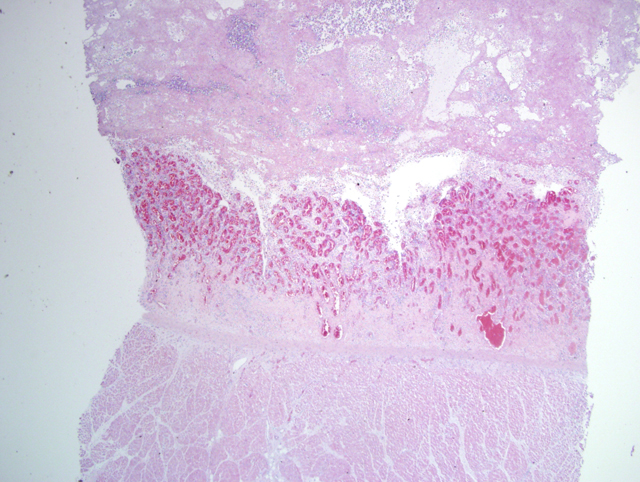Signalment:
Gross Description:
Subacute, severe fibrinous serosanguinous thoracic and peritoneal effusion
Subacute, severe, proliferative, fibrinohemorrhagic pericarditis
Subacute, severe, bilateral pulmonary congestion and edema
Subacute, severe, focally extensive, ventral subcutaneous edema
Histopathologic Description:
Morphologic Diagnosis:
Lab Results:
Condition:
Contributor Comment:
JPC Diagnosis:
Conference Comment:
Conditions potentially associated with fibrinous pericarditis Table extracted from Maxie et al.4 and Van Vleet et al.7
Cattle: Pasteurellosis (Mannheimia haemolytica and Pasteurella multocida), blackleg (Clostridium chauvoei), sporadic bovine encephalomyelitis (Chlamydophila pecorum), contagious bovine pleuropneumonia (Mycoplasma mycoides mycoides small colony type), clostridial hemoglobinuria (Clostridium haemolyticum), neonatal coliform infections (via umbilicus)
Swine: Glasser's disease (Haemophilus suis), pasteurellosis (Pasteurella multocida and Mannheimia haemolytica), porcine enzootic pneumonia (Mycoplasma hyopneumoniae and other agents), salmonellosis, streptococcal infection of piglets
Sheep: Pasteurellosis (Mannheimia haemolytica and Pasteurella trehalosi)
Lambs: Pasteurellosis, streptococci
Horses: Mycoplasma felis, streptococcal polyarthritis with pericarditis, mare reproductive loss syndrome
Cats (rare): Feline infectious peritonitis
Birds: Pssiticosis (Chlamydia psittaci)
Recent articles concerning an epidemic of fibrinous pericarditis, primarily caused by Actinobacillus spp., indicate a strong relationship with mare reproductive loss syndrome (MRLS).1,2,6 MRLS is a syndrome of abortion in horses that occurred in Kentucky in 2001 and 2002. Features of the syndrome include little to no signs of premonitory illness in the mare, hemorrhages in the chorion, amnion, and amniotic segment of the umbilical cord, pleura, and heart.5 Non-β-hemolytic Streptococcus spp. and/or Actinobacillus spp. were isolated in 50% and 20% of the cultured specimens.5 MRLS has been associated with the Eastern tent caterpillar (Malacosoma americanum), specifically the worm exoskeleton and attached setae.2,5 The exact relationship between exposure to the Eastern tent caterpillar, MRLS, and fibrinous pericarditis is not known.1,2,5,6
References:
2. Donahue JM, Sells SF, Bolin DC: Classification of Actinobacillus spp. isolates from horses involved in mare reproductive loss syndrome. Am J Vet Res 67:1426-1432, 2006
3. Knottenbelt DC, Pascoe RR: Disorders of the Cardiovascular System. In: Color Atlas of Diseases and Disorders of the Horse, pp. 170-171. Mosby, New York, New York, 2003
4. Maxie MG, Robinson WF: Cardiovascular system. In: Jubb, Kennedy, and Palmers Pathology of Domestic Animals, ed. Maxie MG, 5th ed., vol. 3, pp. 22-30. Elsevier Limited, St. Louis, MO, 2007
5. Schlafer DH, Miller RB: Female genital system. In: Jubb, Kennedy, and Palmers Pathology of Domestic Animals, ed. Maxie MG, 5th ed., vol. 3, pp. 506-507. Elsevier Limited, St. Louis, MO, 2007
6. Seahorn JL, Slovis NM, Reimer JM, Carey VJ, Donahue JG, Cohen ND: Case-control study of factors associated with fibrinous pericarditis among horses in central Kentucky during spring 2001. J Am Vet Med Assoc 223:832-838, 2003
7. Van Vleet, JF, Ferrans VJ: Cardiovascular system. In: Pathologic Basis of Veterinary Disease, eds. McGavin MD, Zachary JF, 4th ed., pp. 575-578. Elsevier, St. Louis, MO, 2007
